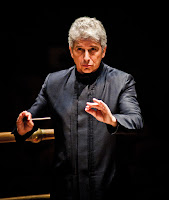Peter Oundjian steps in again as ISO's abbreviated concert season nears an end
 |
| Peter Oundjian, ISO guest conductor |
With pandemic-related travel restrictions keeping Krzysztof Urbanski, the Indianapolis Symphony Orchestra's outgoing music director, from putting a cap on his ten-year tenure, Peter Oundjian has stepped in once again.
In two appearances at Hilbert Circle Theatre this weekend (the second one starts at 5:30 p.m. today), Oundjian enjoys the onstage company of returning concerto favorite Garrick Ohlsson as soloist in Chopin's Piano Concerto No. 2 in F minor.
Heard in the ISO program's debut Friday night, Oundjian confirmed the directness and vitality of his conducting, not only in his sensitive partnership with Ohlsson but in the intermissionless concert's concluding work, Tchaikovsky's Symphony No. 5 in E minor.
An acknowledged super-interpreter of Chopin's music ever since he won the Polish competition named for
 |
| Once again, Garrick Ohlsson shines in Chopin. |
the composer in 1970, Ohlsson offered a mellow, luminous account of the concerto. Everything about it seemed keyed to the piano's thoughtful entrance in the first movement. It was assured in being somewhat understated, in contrast to the orchestra's uncertain introduction at its outset.
The orchestra gained stature in its accompaniment role as Ohlsson laid out his pearly lyricism, always well articulated. In the second movement, the pianist was not excessively concerned with ringing out those octaves in the treble above orchestral tremolos, the way one often hears. Chopin's command of the orchestra never seems distinguished, but Oundjian elicited from the ISO vivid tone colors where they could be found, as in the particularly Polish, rootsy episodes of the rondo finale. Everything served to allow Ohlsson the space he deserved to inflect every measure of the score with his idiomatic mastery.
A flubbed horn solo introducing the denouement of the last movement fortunately faded in memory by the time in the Tchaikovsky Fifth when Rob Danforth stated indelibly the imperishable melody of the Andante cantabile second movement (which to our parents and grandparents surfaced as the pop hit "Moon Love"). Oundjian had the lower strings set down a soft, throbbing introduction to that tune, which helped it make its wonted, passionate impression. Subsequently, the movement's cameo portraits of wind instruments moved into and out of the spotlight glowingly.
Pacing throughout the symphony, which is so compellingly varied amid the riot of orchestral color and melodiousness, was first-rate. Oundjian's gestures looked clear and no-nonsense, all of them calculated to produce rhythmic impact and to raise the work's dramatic profile as high as a unified flow might allow.
The waltz movement locked into an authentic lilt, and in the shaping of its winning phrases, the violas were especially adept. The finale featured such an array of variation in texture and dynamics that the repeated "Fate" theme never became tedious. Every time it burst into prominence, it felt welcome, largely because the movement's variety had been so scrupulously served. It was a treat to hear our local orchestra in full cry once again, and the musicians sounded as if they were relishing the opportunity.



Comments
Post a Comment